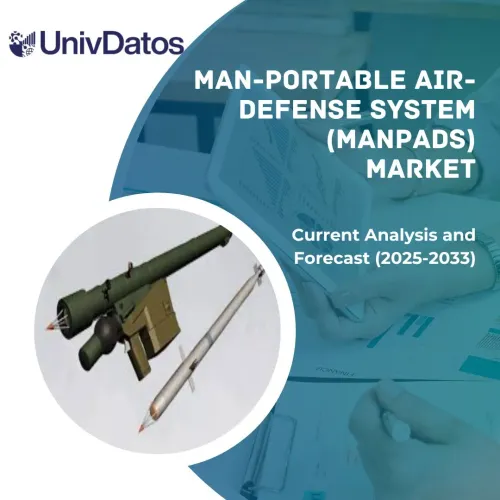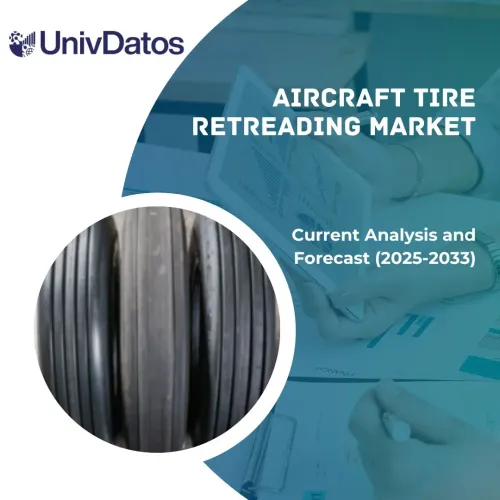- Home
- About Us
- Industry
- Services
- Reading
- Contact Us
Aerospace Riveting Equipment Market: Current Analysis and Forecast (2025-2033)
Emphasis on Rivet Type (Solid Rivet, Blind Rivet, and Semi-Tubular Rivet); Equipment Type (Hydraulic Equipment, Pneumatic Equipment, and Electric Equipment); Technology (Automated Equipment and Manual Equipment); End-Use (Original Equipment Manufacturers (OEM) and Maintenance, Repair, and Overhaul (MRO)); and Region/Country
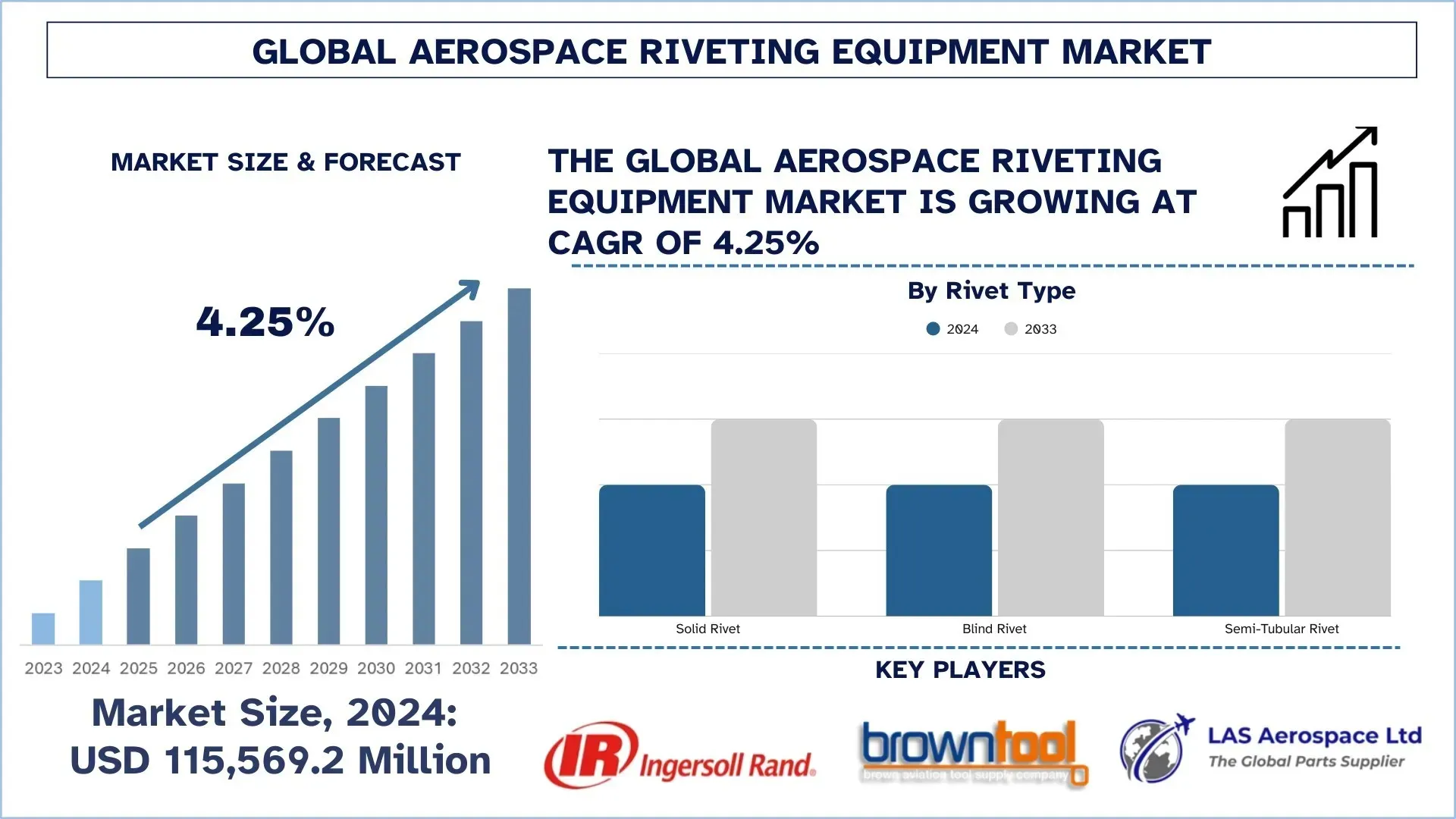
Global Aerospace Riveting Equipment Market Size & Forecast
The Global Aerospace Riveting Equipment Market was valued at USD 115,569.2 million in 2024 and is expected to grow at a strong CAGR of around 4.25% during the forecast period (2025-2033F), driven by increasing aircraft production, rising demand for lightweight and fuel-efficient materials, and advancements in automated and smart riveting technologies.
Aerospace Riveting Equipment Market Analysis
Aerospace riveting equipment is an advanced tool and system that is used to join, overhaul, and bolster airframe structures. Riveting is a fastening method that is used in aerospace due to its robustness, endurance, and ability to combat vibration and cyclic stress. The market offers a wide range of products, including rivet guns, blind rivet tools, squeeze riveters, and automated fixed riveting systems designed for large-scale assembly lines. Rising demand for air travel and fleet modernization programs is driving the need for effective and robust fastening methods. Additionally, the growing demand for lightweight materials and superalloys in aircraft manufacturing is driving the growth of the market. The increasing demand for line maintenance to enhance aircraft operational condition and service life is driving the market growth. Moreover, the integration of advanced technologies such as robotics, automation, and digital monitoring for improving the quality control, productivity, and structural integrity in riveting methods further drives the growth of equipment globally.
Global Aerospace Riveting Equipment Market Trends
This section discusses the key market trends that are influencing the various segments of the global aerospace riveting equipment market, as found by our team of research experts.
Growing Customization in Riveting System
Growing customization in riveting systems is one of the prominent key trends in the aerospace riveting equipment market. Aeronautical companies are largely seeking tools that can handle complex tasks and aircraft parts to expand their product line. Customized riveting equipment allows OEMs and MRO providers to achieve higher accuracy, minimize material damage, and meet specific performance standards for both commercial and defense aircraft. Additionally, the growing use of lightweight materials in aircraft production is further accelerating this trend. Therefore, by providing customized tools, manufacturers can improve efficiency, avoid damage, and provide value-added services, making customization an important part of a competitive global market. For example, in 2025, Rivit launched new compatibility kits for its RIV720 battery-powered riveting tool, providing the installation of Gtreriv rivets with diameters up to 7.7 mm, specifically designed for the energy sector. This advancement has exceeded the previous maximum of 6.4 mm supported by the 700 Series tools.
Aerospace Riveting Equipment Industry Segmentation
This section provides an analysis of the key trends in each segment of the global aerospace riveting equipment market report, along with forecasts at the global, regional, and country levels for 2025-2033.
The Blind Rivet Segment Dominates the Global Aerospace Riveting Equipment Market
Based on the rivet type, the market is categorized into solid rivet, blind rivet, and semi-tubular rivet. Among these, the blind rivet segment dominated the aerospace riveting equipment market due to its simplicity, ease of installation, robustness, and reliability. These rivets are used in circumstances where only one side of the workpiece is accessible. However, the solid rivet segment is showing the fastest growth due to its unrivaled durability, superior engineering, and performance in key structure applications such as fuselage and wing assembly. Additionally, the increasing aircraft manufacturing and fleet upgradation are driving the growth of solid rivets in the market.
The Pneumatic Equipment Segment Dominates the Global Aerospace Riveting Equipment Market.
Based on equipment type, the market is categorized into environmental hydraulic equipment, pneumatic equipment, and electric equipment. Among these, the pneumatic equipment segment dominated the market due to its lightweight, cost-effectiveness, high efficiency, and precision. They are crucial in aerospace assembly lines due to ease of maintenance and have the capability of providing a consistent force for repetitive tasks. However, the electric equipment is showing the fastest growth. This is due to the growing demand for energy-saving systems that offer controlled force, accuracy, and low running costs. Additionally, these rivets easily integrate with the automated production process, thereby driving the growth of the market.
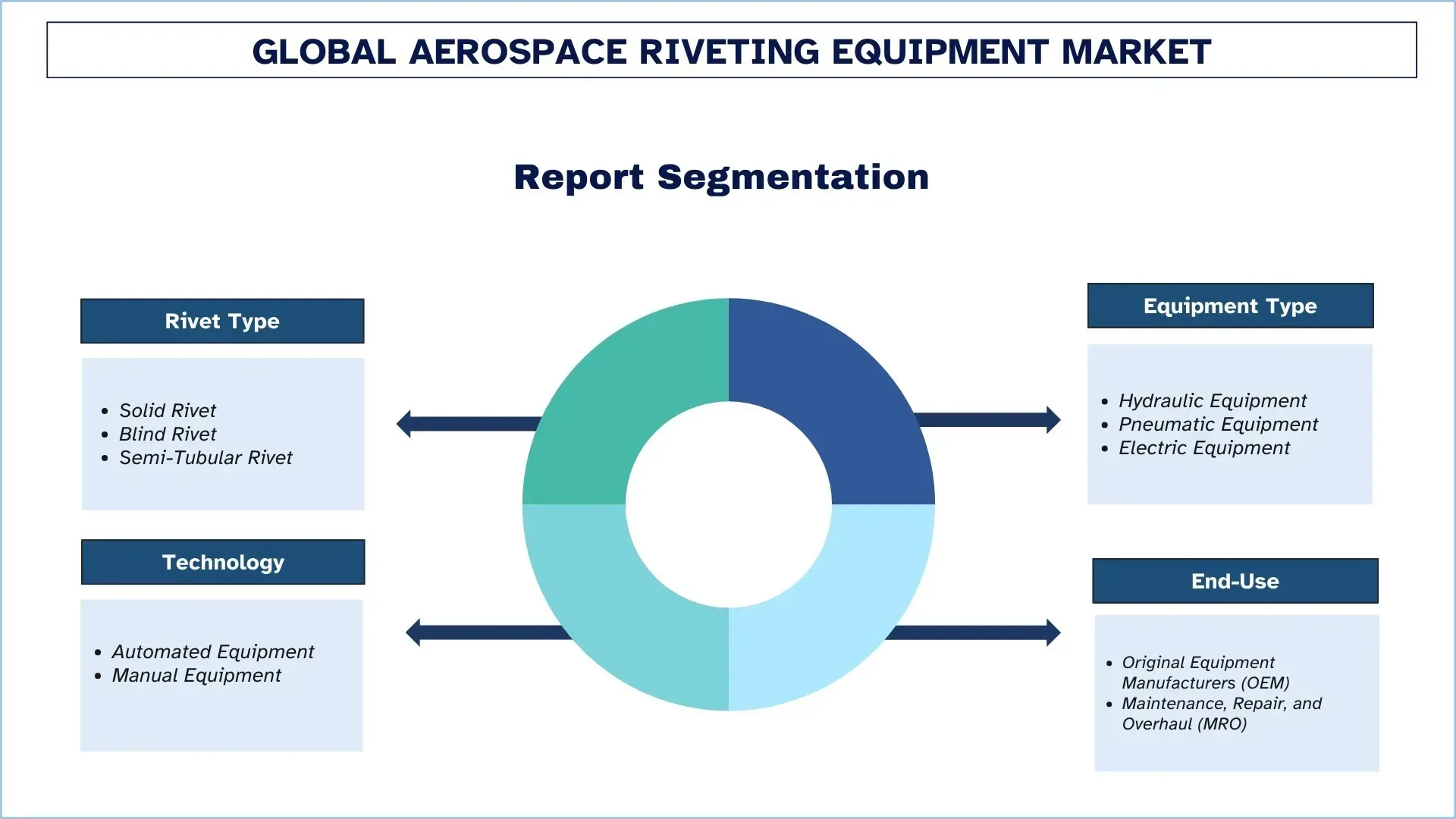
North America holds the largest market share in the Global Aerospace Riveting Equipment market
North America dominated the aerospace riveting equipment market. This is due to the presence of major aircraft manufacturers, smart aerospace infrastructure, and increasing investments in the R&D department. The region is a hub of major OEMs such as Boeing, Lockheed Martin, and Northrop Grumman, driving the continuous demand for specialized riveting tools in aircraft construction. Furthermore, the presence of the MRO industry and the rising utilization of automated and robotic manufacturing technologies further improve its position in the market. Moreover, supportive government policies, strong defense spending, and continuous technological advancement also make North America lead the global aerospace riveting equipment market.
The U.S. held a Dominant share of the North America Aerospace Riveting Equipment Market in 2024
The United States dominated the aerospace riveting equipment market. This is due to the presence of aircraft and defense producers, such as Boeing, Lockheed Martin, and Raytheon Technologies. The presence of a well-established aerospace distribution network, advanced manufacturing facilities, and a high demand for automated riveting technologies further drives the growth of the market. Additionally, strong government and defense investment in new aircraft programs further drives the demand for advanced riveting equipment. The continuous investments in the R&D department and the presence of a strong MRO industry improve the innovation in fastening technologies. With a combination of large-scale aircraft production, cutting-edge technology adoption, and a strong focus on defense and commercial aviation, the U.S. has secured a dominant position in the global market.
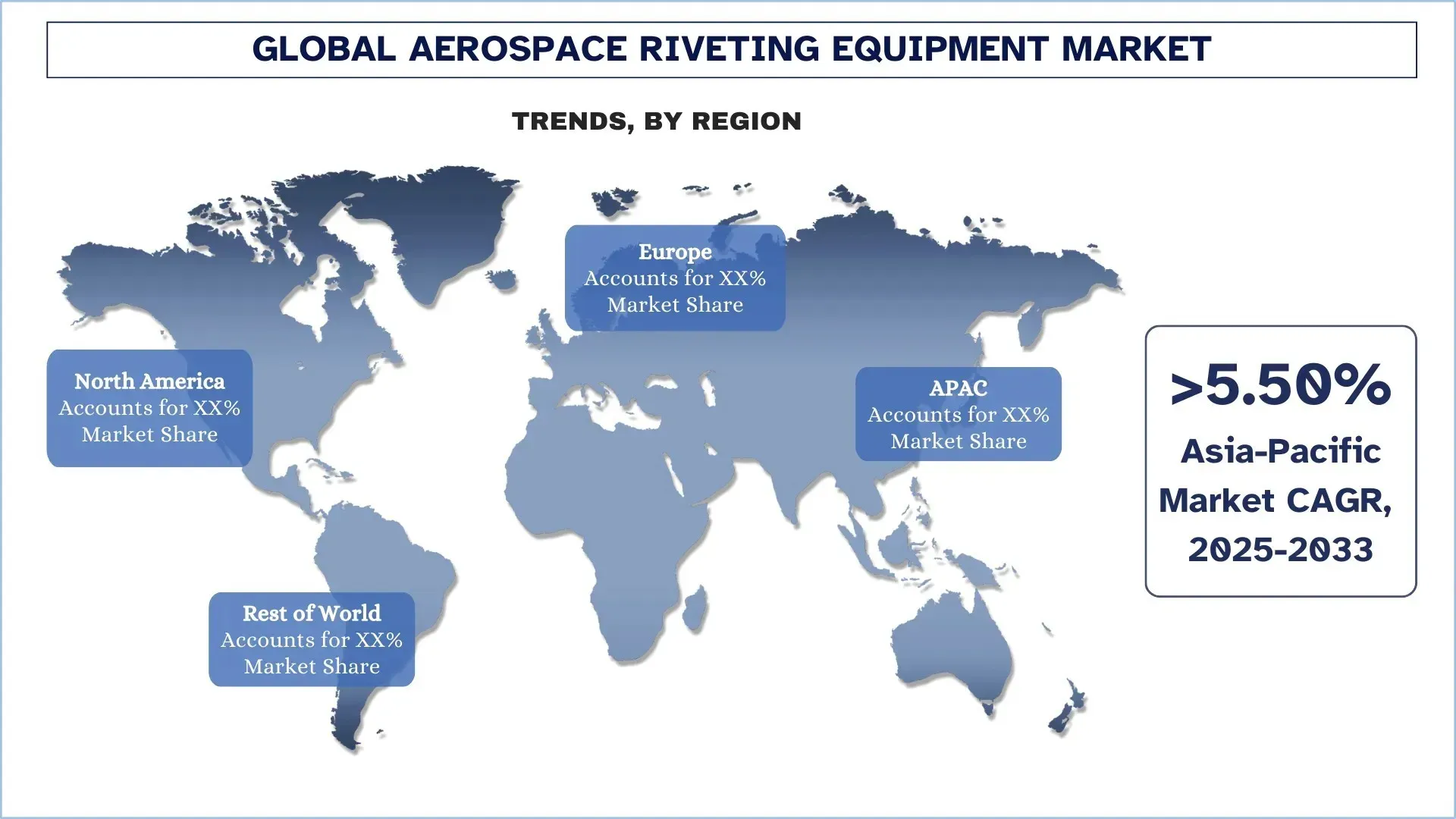
Aerospace Riveting Equipment Industry Competitive Landscape
The global aerospace riveting equipment market is competitive, with several global and international market players. The key players are adopting different growth strategies to enhance their market presence, such as partnerships, agreements, collaborations, geographical expansions, and mergers and acquisitions.
Top Aerospace Riveting Equipment Market Companies
Some of the major players in the market are Ingersoll Rand Inc., Brown Aviation & Aircraft Tools, LAS Aerospace Ltd., Orbitform Group, LLC., Precision Castparts Corp. (Cherry Aerospace), GESIPA (SFS Group), Howmet Aerospace Inc., Orbital Systems (Bombay) Private Limited, Atlas Copco AB, and Broetje-Automation GmbH
Recent Developments in the Aerospace Riveting Equipment Market
In March 2025, AGME launched automated riveting machines based on the standards of Industry 4.0, providing advanced accuracy and robustness. The machine reduces downtime and boosts productivity, making it suitable for aerospace and automotive industrial applications.
In July 2025, at Blechexpo in Stuttgart, Gesipa introduced the GAV-Neo is an automated blind riveting system offering high setting force, short cycle times, and fully electric, oil-free operation, making it ideal for automated production lines.
Global Aerospace Riveting Equipment Market Report Coverage
Report Attribute | Details |
Base year | 2024 |
Forecast period | 2025-2033 |
Growth momentum | Accelerate at a CAGR of 4.25% |
Market size 2024 | USD 115,569.2 million |
Regional analysis | North America, Europe, APAC, Rest of the World |
Major contributing region | The North America region is expected to dominate the market during the forecast period. |
Key countries covered | U.S., Canada, Germany, U.K., Spain, Italy, France, China, Japan, South Korea, and India. |
Companies profiled | Ingersoll Rand Inc., Brown Aviation & Aircraft Tools, LAS Aerospace Ltd., Orbitform Group, LLC., Precision Castparts Corp. (Cherry Aerospace), GESIPA (SFS Group), Howmet Aerospace Inc., Orbital Systems (Bombay) Private Limited, Atlas Copco AB, and Broetje-Automation GmbH |
Report Scope | Market Trends, Drivers, and Restraints; Revenue Estimation and Forecast; Segmentation Analysis; Demand and Supply Side Analysis; Competitive Landscape; Company Profiling |
Segments Covered | By Rivet Type, By Equipment Type, By Technology, By End-Use, and By Region/Country |
Reasons to Buy the Aerospace Riveting Equipment Market Report:
The study includes market sizing and forecasting analysis confirmed by authenticated key industry experts.
The report briefly reviews overall industry performance at a glance.
The report covers an in-depth analysis of prominent industry peers, primarily focusing on key business financials, type portfolios, expansion strategies, and recent developments.
Detailed examination of drivers, restraints, key trends, and opportunities prevailing in the industry.
The study comprehensively covers the market across different segments.
Deep dive regional level analysis of the industry.
Customization Options:
The global aerospace riveting equipment market can further be customized as per the requirements or any other market segment. Besides this, UnivDatos understands that you may have your own business needs; hence, feel free to contact us to get a report that completely suits your requirements.
Table of Content
Research Methodology for the Global Aerospace Riveting Equipment Market Analysis (2023-2033)
We analyzed the historical market, estimated the current market, and forecasted the future market of the global aerospace riveting equipment market to assess its application in major regions worldwide. We conducted exhaustive secondary research to gather historical market data and estimate the current market size. To validate these insights, we carefully reviewed numerous findings and assumptions. Additionally, we conducted in-depth primary interviews with industry experts across the aerospace riveting equipment value chain. After validating market figures through these interviews, we used both top-down and bottom-up approaches to forecast the overall market size. We then employed market breakdown and data triangulation methods to estimate and analyze the market size of industry segments and sub-segments.
Market Engineering
We employed the data triangulation technique to finalize the overall market estimation and derive precise statistical numbers for each segment and sub-segment of the global aerospace riveting equipment market. We split the data into several segments and sub-segments by analyzing various parameters and trends, including rivet type, equipment type, technology, end-use, and regions within the global aerospace riveting equipment market.
The Main Objective of the Global Aerospace Riveting Equipment Market Study
The study identifies current and future trends in the global aerospace riveting equipment market, providing strategic insights for investors. It highlights regional market attractiveness, enabling industry participants to tap into untapped markets and gain a first-mover advantage. Other quantitative goals of the studies include:
Market Size Analysis: Assess the current and forecast market size of the global aerospace riveting equipment market and its segments in terms of value (USD).
Aerospace Riveting Equipment Market Segmentation: Segments in the study include areas of rivet type, equipment type, technology, end-use, and region.
Regulatory Framework & Value Chain Analysis: Examine the regulatory framework, value chain, customer behavior, and competitive landscape of the aerospace riveting equipment industry.
Regional Analysis: Conduct a detailed regional analysis for key areas such as Asia Pacific, Europe, North America, and the Rest of the World.
Company Profiles & Growth Strategies: Company profiles of the aerospace riveting equipment market and the growth strategies adopted by the market players to sustain the fast-growing market.
Frequently Asked Questions FAQs
Q1: What is the global aerospace riveting equipment market’s current market size and growth potential?
As of 2024, the global aerospace riveting equipment market is valued at USD 115,569.2 million and is projected to grow at an impressive CAGR of 4.25% from 2025 to 2033. This growth is driven by increasing demand for advanced riveting solutions in aircraft manufacturing and the rising adoption of automated and robotic riveting systems.
Q2: Which segment has the largest share of the global aerospace riveting equipment market by rivet type category?
The blind rivet segment holds the largest share of the global aerospace riveting equipment market. Its popularity stems from ease of installation, reduced labor requirements, and suitability for aircraft fuselage and structural assemblies.
Q3: What are the driving factors for the growth of the global aerospace riveting equipment market?
Top growth drivers of the aerospace riveting equipment market include:
• Technological advancements in aerospace manufacturing, enhancing precision and productivity.
• Increasing use of lightweight materials like aluminum and composites in aircraft construction.
• Expansion of portable and automated riveting tools, improving efficiency in assembly lines.
Q4: What are the emerging technologies and trends in the global aerospace riveting equipment market?
Emerging trends in the aerospace riveting equipment market include:
• Customization of riveting systems to meet specific aircraft manufacturing requirements
• Integration of robotics and automation in riveting processes for higher accuracy and reduced production time.
• Growing emphasis on smart rivet monitoring systems to ensure safety and quality.
Q5: What are the key challenges in the global aerospace riveting equipment market?
Key challenges in the aerospace riveting equipment market include:
• High initial investment costs for advanced machinery and automated systems
• Technological complexity, requiring skilled operators and ongoing maintenance.
• Competition from alternative joining techniques like adhesive bonding in certain applications.
Q6: Which region dominates the global aerospace riveting equipment market?
North America dominates the global aerospace riveting equipment market. This is due to advanced aerospace manufacturing infrastructure, early adoption of automated and robotic riveting systems, and strong regulatory compliance and safety standards are driving demand for high-quality riveting solutions.
Q7: Who are the key competitors in the global aerospace riveting equipment market?
Top players in the Aerospace riveting equipment industry include:
• Ingersoll Rand Inc.
• Brown Aviation & Aircraft Tools
• LAS Aerospace Ltd.
• Orbitform Group, LLC.
• Precision Castparts Corp. (Cherry Aerospace)
• GESIPA (SFS Group)
• Howmet Aerospace Inc.
• Orbital Systems (Bombay) Private Limited
• Atlas Copco AB
• Broetje-Automation GmbH
Q8: How is automation transforming the aerospace riveting equipment industry?
Automation is revolutionizing the aerospace riveting equipment market by enabling robotic riveting systems, precision alignment, and faster assembly lines. Manufacturers are increasingly adopting AI-driven quality monitoring and automated rivet inspection tools, which reduce errors, lower labor costs, and improve overall production efficiency.
Q9: What investment opportunities exist in the aerospace riveting equipment market?
Investment opportunities are strong in automated and robotic riveting solutions, portable riveting tools, and smart rivet monitoring systems. With the global aircraft production rising and manufacturers seeking efficient, lightweight assembly methods, investors can capitalize on companies offering technologically advanced and customized riveting solutions.
Related Reports
Customers who bought this item also bought





